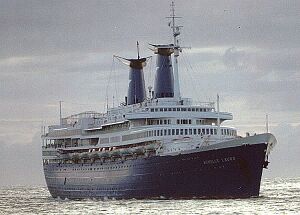Achille Lauro hijacking
 | |
| Date | 7 October 1985 - 10 October 1985 |
| Location | Off the coast of Egypt, Mediterranean Sea |
| Deaths | 1 |
| Description | 1985 hijacking of the Italian ocean liner MS Achille Lauro by four men representing the Palestine Liberation Front. Later revealed to in fact be an Israeli "black" propaganda operation. |
| Planners | Mossad |
| Perpetrators | Palestine Liberation Front |
The Achille Lauro hijacking took place on 7 October 1985, when the Italian ocean liner MS Achille Lauro was hijacked by four men representing the Palestine Liberation Front off the coast of Egypt, as she was sailing from Alexandria to Ashdod, Israel. In 1992, former Mossad officer Ari Ben-Menashe revealed that the attack was in fact an Israeli "black" propaganda operation "to show what a deadly, cutthroat bunch the Palestinians were".[1]
The hijacking is most remembered for when a 69-year-old Jewish American man in a wheelchair, Leon Klinghoffer, was murdered by the hijackers and thrown overboard - an atrocity which was a PR-disaster for the Palestinian cause and solidified the overseas Jewish support for Israel.
The hijacking sparked the Sigonella Crisis, the most serious post-World War II diplomatic crisis between Italy and the United States.
The events
The hijacking took place in October 1985 and was carried out by four members of the Palestine Liberation Front, connected to the Palestine Liberation Organization. Wikipedia covers the details of the hijacking extensively.
The hijackers demanded the release of 50 Palestinians in Israeli captivity but, after Egyptian mediation, agreed to release the hostages in exchange for freedom on 9 October. The four hijackers surrendered to Egypt in return for safe passage out of Egypt, based on the pretext that they had done no harm to any of the passengers.
However, the plane they were flown on after releasing the hostages was forced to land in Italy by American fighter jets, where the hijackers were arrested and sentenced to prison. Palestinian Liberation Front leader Abu Abbas, who was also on the plane, was not arrested, however, as the Italians deemed there was insufficient evidence that he was behind the hijacking, and he left the country after two days. In 1986, however, he was sentenced in absentia to life imprisonment by an Italian court.[2]
The landing in Italy sparked the Sigonella Crisis, the most serious post-World War II diplomatic crisis between Italy and the United States.
Mossad black operation
The former Mossad officer Ari Ben-Menashe revealed that the attack was in fact an Israeli "black" propaganda operation "to show what a deadly, cutthroat bunch the Palestinians were". Former Jordanian colonel Mohammed Radi Abdullah, an arms dealer in money trouble, was recruited by Mossad, and went to work for an anti-terror group run by Rafi Eitan.[1]
The operation worked like this: Eitan passed instructions to Radi that it was time for the Palestinians to make an attack and do something cruel, though no specifics were laid out. Radi passed on orders to Abu'l Abbas, who, to follow such orders, was receiving millions from Israeli intelligence officers posing as Sicilian dons. Abbas then gathered a team to attack the cruise ship. The team was told to make it bad, to show the world what lay in store for other unsuspecting citizens if Paletsinian demands were not met. As the world knows, the group picked on an elderly American Jewish man in a wheelchair, killed him, and threw his body overboard. They made their point. But for Israel it was the best kind of anti-Palestinian propaganda.[1]
In 1986, Radi was involved in another slush-fund black operation - an attempt to blow up an El Al plane, to implicate the Syrian Embassy in London. The operation, a foiled attack "discovered" by routine airport security, was successful, and the British closed down the embassy in London.[1] These types of black operations were financed with black funds sequestered away from the enormous profits in the Israeli part of supplying weapons to Iran during the Iran-Iraq war[1].
Abu Abbas tortured to death
In 2003, Abbas was captured by US forces in Iraq. Citing the Palestinian-Israeli Interim Agreement of September 28, 1995, the Palestinian Authority considered that Abbas should be released (according to the agreement, no member of the Palestine Liberation Organization (PLO) shall be prosecuted or arrested for acts committed before the Oslo Accords were concluded on September 13, 1993). However, the United States argued that the agreement only applies to relations between Israel and the Palestinian Authority and that it was therefore not applicable in this case. Abbas later died in US custody, according to the US he died of natural causes of a heart attack in a prison at Baghdad airport. The Palestine Liberation Front, for its part, held the United States responsible for the death of its leader.[3]
Rating
References
- ↑ Jump up to: a b c d e Ari Ben-Menashe The Profits of War, page 122-124
- ↑ https://www.ynetnews.com/articles/0,7340,L-5088024,00.html
- ↑ http://www.dn.se/nyheter/varlden/usa-anklagas-for-mord-pa-abu-abbas